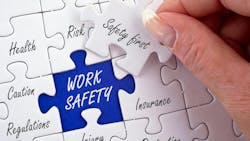Key Takeaways
- Safety perceptions vary across organizational levels, from management to employees, affecting overall safety culture.
- Personal responsibility and proactive safety practices are crucial for creating a safer, more productive work environment.
- Leadership's commitment to safety influences employee behavior and organizational safety culture.
- Effective safety programs involve planning, communication, hazard identification, proper tool use, and working methodically.
- A strong safety culture benefits companies by improving retention, productivity, and work quality.
The first word on our list is “safety.” It’s not defined in NFPA 70E. What does it mean to you? Here are some views on its meaning:
A-level CEO or company president. It’s what we do to protect our employees. I hold every member of management responsible for the success of our safety program, starting with me. I personally go on safety tours, and people ask me where I find the time. What is a better use of my time than employee safety?
C-level CEO or company president. We have a safety program. I looked at it just last quarter. The supervisors know they are responsible for carrying it out.
F-level CEO or company president. We check all of the boxes, in case OSHA comes after us.
A-level supervisor. It’s what I do and get my people to do so that nobody gets hurt on the job.
C-level supervisor. I see which people I can catch not wearing their safety glasses.
F-level supervisor. That stuff really gets in my way. And some people use it as an excuse to goof off.
F-level employee. I have a system for getting around all that nonsense, so I can get my work down.
C-level employee. I comply with what they tell me to do in regard to safety.
A-level employee. My safety, and that of my coworkers, is baked into everything I do. I work methodically, I am not distracted while on the job, and I make a point of continually expanding my skills in this area.
Notice the use of “I” by the A-level people. Notice the use of “they” by the C-level people. Can you see who actually embraces safety and who merely pretends to?
The A-level employee takes personal responsibility for his safety, while the C-level employee relies on his employer to somehow anticipate every danger he might encounter and somehow protect him against it. Which one do you think is safer? Which one do you think does better work? Which one do you aspire to be each day? Which one do you think exemplifies the true meaning of safety? Is that you? If not, why not?
Safety isn’t abstract, it isn’t an extra layer of work, and it’s not in the way of getting your job done. Safety is your primary job. Here are six key elements of doing that job correctly:
- Planning the work.
- Communicating safety issues with coworkers (for example, the job briefing).
- Identifying potential dangers and how to protect yourself from them.
- Using the correct tools and ensuring they are in good working condition. Ditto for test equipment, lifts, ladders, and PPE.
- Working the plan, and working it methodically.
- Stopping when a new danger arises, and solving for it.
In some company cultures, people try to see what they can get by with instead of how to protect themselves. Those companies operate at a distinct disadvantage. That same mindset results in reduced productivity and reduced quality of work. Supervisors spend much of their time cracking the proverbial whip.
In other company cultures, people try to see how well they can do their jobs and they understand that protecting themselves is part of their job. Those companies operate at a distinct advantage. They are able to hire and retain the best, most conscientious people. Supervisors spend most of their time solving system problems for the workers instead of managing problem workers. All because people place a premium on safety, starting with that person in the big corner office.
So, what does safety mean in your company? What does it mean to you? As an exercise, pick someone at work and ask both of these questions. Then pick another person and repeat this. If people balk at answering it, your company has some work to do. It might be a good career move to ask for a lead role in doing that work. But if nobody in management seems to care that the company is falling short in the area of safety, it may be time to move on. Remember that principle about protecting yourself.
About the Author

Mark Lamendola
Mark is an expert in maintenance management, having racked up an impressive track record during his time working in the field. He also has extensive knowledge of, and practical expertise with, the National Electrical Code (NEC). Through his consulting business, he provides articles and training materials on electrical topics, specializing in making difficult subjects easy to understand and focusing on the practical aspects of electrical work.
Prior to starting his own business, Mark served as the Technical Editor on EC&M for six years, worked three years in nuclear maintenance, six years as a contract project engineer/project manager, three years as a systems engineer, and three years in plant maintenance management.
Mark earned an AAS degree from Rock Valley College, a BSEET from Columbia Pacific University, and an MBA from Lake Erie College. He’s also completed several related certifications over the years and even was formerly licensed as a Master Electrician. He is a Senior Member of the IEEE and past Chairman of the Kansas City Chapters of both the IEEE and the IEEE Computer Society. Mark also served as the program director for, a board member of, and webmaster of, the Midwest Chapter of the 7x24 Exchange. He has also held memberships with the following organizations: NETA, NFPA, International Association of Webmasters, and Institute of Certified Professional Managers.
